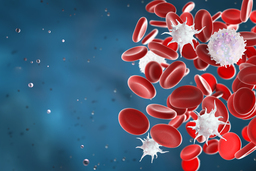Polydiacetylene Liposome Microarray toward Facile Measurement of Platelet Activation in Whole Blood
TECHNOLOGY NUMBER: 2022-020
Tags:

OVERVIEW
A single-step, rapid result microarray to measure platelet activation in whole blood- An antibody-liposome microarray generates a fluorescent signal with activated platelets
- The test may be completed quickly to guide treatment for patients with acute conditions
BACKGROUND
Platelets play a pivotal role in normal hemostasis, and abnormally high platelet functioning can cause coronary artery disease (CAD), cerebrovascular accident (CVA), or peripheral vascular occlusive disease (PVOD). While patients may inherit a disposition for abnormal clotting, platelet dysfunction may result from circumstances such as sepsis, malignancies, extra-corporeal circulation, the presence of prosthetic heart valves, or dialysis. Alternatively, abnormally low platelet levels or functioning correlate with uncontrolled bleeding and an inability to safely undergo surgery. The causes of thrombocytopenia may include primary bone marrow insufficiency due to hematologic malignancies or secondary dysfunction caused by delivery of cytotoxic chemotherapy. Perhaps the most common causes for decreased platelet functioning results from the iatrogenic effects of antiplatelet drugs prescribed for the treatment of CAD, CVA and PVOD. Given the complex nature of clotting, a need exists for a simple, quantitative measure of platelet function to guide clinicians who treat these conditions.
INNOVATION
Researchers at the University of Michigan have developed a self-signaling polydiacetylene (PDA) liposome microarray to detect activated platelets from whole blood samples in a single step. The inventors employ an antibody called 9F9 which is specific to platelet-bound fibrinogen and that conjugates with the polydiacetylene (PDA) liposome microarray to generate an intense fluorescence signal when contacted with activated platelets in whole blood. The PDA liposome assay allows for evaluation of samples without the need for complex blood cell separation equipment or additional in vitro platelet stimulation with exogenous agonists such as collagen.Testing reveals that the microarray successfully quantifies the degree of reduced platelet activation induced by the presence of varying amounts of Tirofiban, a model antiplatelet drug. This approach is also sensitive enough to assess reduced platelet function of patients on low dose aspirin or on antiplatelet drugs. The bench-top assay requires 20 minutes or less to complete and can therefore efficiently direct therapy for patients with acute presentations of angina pectoris or stroke. Further uses of the technology include identifying patients with bleeding disorders, monitoring responses to antiplatelet treatments, evaluating perioperative hemostasis, and guiding transfusion medicine.